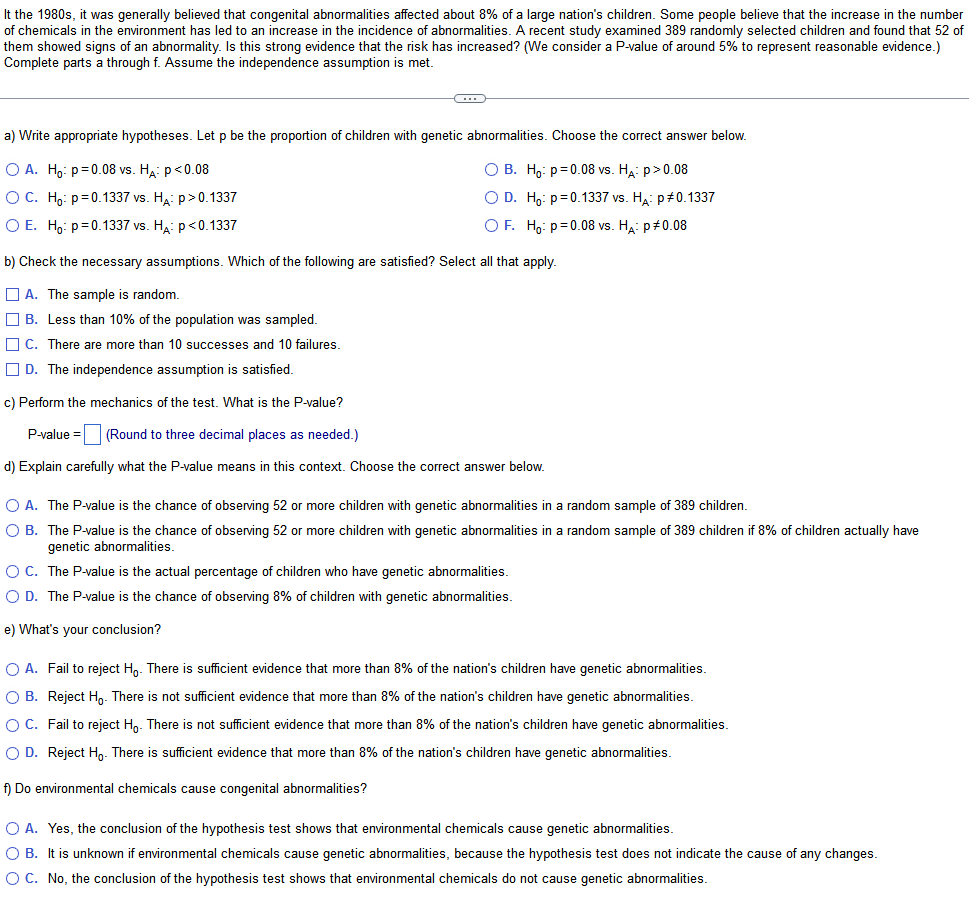Home /
Expert Answers /
Statistics and Probability /
it-the-1980-s-it-was-generally-believed-that-congenital-abnormalities-affected-about-8-o-pa150
(Solved): It the 1980 s, it was generally believed that congenital abnormalities affected about \( 8 \% \) o ...
It the 1980 s, it was generally believed that congenital abnormalities affected about \( 8 \% \) of a large nation's children. Some people believe that the increase in the number of chemicals in the environment has led to an increase in the incidence of abnormalities. A recent study examined 389 randomly selected children and found 52 of them showed signs of an abnormality. Is this strong evidence that the risk has increased? (We consider a P-value of around \( 5 \% \) to represent reasonable evidence.) Complete parts a through \( \mathrm{f} \). Assume the independence assumption is met. a) Write appropriate hypotheses. Let \( p \) be the proportion of children with genetic abnormalities. Choose the correct answer below. A. \( \mathrm{H}_{0}: \mathrm{p}=0.08 \) vs. \( \mathrm{H}_{\mathrm{A}}: \mathrm{p}<0.08 \) B. \( H_{0}: p=0.08 \) vs. \( H_{A}: p>0.08 \) C. \( \mathrm{H}_{0}: \mathrm{p}=0.1337 \) vs. \( \mathrm{H}_{\mathrm{A}}: \mathrm{p}>0.1337 \) D. \( H_{0}: p=0.1337 \) vs. \( H_{A}: p \neq 0.1337 \) E. \( \mathrm{H}_{0}: \mathrm{p}=0.1337 \) vs. \( \mathrm{H}_{\mathrm{A}}: \mathrm{p}<0.1337 \) F. \( H_{0}: p=0.08 \) vs. \( H_{A}: p \neq 0.08 \) b) Check the necessary assumptions. Which of the following are satisfied? Select all that apply. A. The sample is random. B. Less than \( 10 \% \) of the population was sampled. C. There are more than 10 successes and 10 failures. D. The independence assumption is satisfied. c) Perform the mechanics of the test. What is the P-value? P-value \( =\quad \) (Round to three decimal places as needed.) d) Explain carefully what the P-value means in this context. Choose the correct answer below. A. The P-value is the chance of observing 52 or more children with genetic abnormalities in a random sample of 389 children. B. The P-value is the chance of observing 52 or more children with genetic abnormalities in a random sample of 389 children if \( 8 \% \) of children actually have genetic abnormalities. C. The P-value is the actual percentage of children who have genetic abnormalities. D. The P-value is the chance of observing \( 8 \% \) of children with genetic abnormalities. e) What's your conclusion? A. Fail to reject \( \mathrm{H}_{0} \). There is sufficient evidence that more than \( 8 \% \) of the nation's children have genetic abnormalities. B. Reject \( \mathrm{H}_{0} \). There is not sufficient evidence that more than \( 8 \% \) of the nation's children have genetic abnormalities. C. Fail to reject \( \mathrm{H}_{0} \). There is not sufficient evidence that more than \( 8 \% \) of the nation's children have genetic abnormalities. D. Reject \( \mathrm{H}_{0} \). There is sufficient evidence that more than \( 8 \% \) of the nation's children have genetic abnormalities. f) Do environmental chemicals cause congenital abnormalities?
